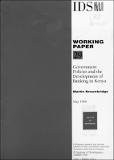| dc.description.abstract | The growth of the Kenyan economy since independence has been accompanied by an
expansion and diversification of the financial system. In terms o f the numbers and range of
financial institutions (FIs) and the depth of financial intermediation, financial development has
proceeded further in Kenya than in most other countries in Sub-Saharan Africa (SSA). By the
early 1990s the financial sector included commercial banks, non bank financial institutions
(NBFIs), development finance institutions (DFIs), insurance companies and a stock exchange.
The commercial banks and NBFIs, which are the focus o f this paper, include government
owned, foreign owned and locally owned private sector FIs. Government intervention in the
financial system has been extensive, although the degree and nature o f influence and control it
has exerted has varied considerably both between and within the different sectors.
This paper examines the development since independence o f the banking system (the
commercial banks and the NBFIs) and in particular how it was shaped by government policies.
The aim is to explore a number of related themes: whether financial repression retarded the
development of the banking system, did the government attempt to influence credit allocation
and did this undermine the quality of FIs' asset portfolios?, how effective was prudential
regulation? have financial sector reforms achieved their objectives of promoting a more
competitive, efficient and prudentially sound banking system? The organisation of the
paper is as follows. Section 2 presents an outline o f the main elements o f government policy
and intervention in the financial system. Sections 3, 4 and 5 review the experience and
performance of the government owned commercial banks, the foreign owned commercial
banks, and the local private sector commercial banks and NBFIs respectively. The emergence
of the locally owned private sector financial institutions (FIs) has been characterised by several
episodes of bank failure since the mid 1980s, the causes of which are discussed in section 6.
Section 7 examines the links between financial fragility and the system o f prudential regulation
and supervision: this section also assesses the impact o f the reforms to the regulatory system
undertaken since the mid 1980s. Section 8 outlines the main elements of the financial
liberalisation introduced since the early 1980s and discusses their impact on the banking
system. Section 9 concludes.2
The rest of this introduction provides a very brief overview o f the financial system in
Kenya and its development since independence. The financial system at independence in 1963
consisted of nine foreign owned commercial banks, of which the largest were Barclays,
Standard Chartered and National and Grindlays, together with several NBFIs and DFIs. In the
decade following independence the government established the Central Bank of Kenya (CBK),
three parastatal commercial banks and a number o f DFIs. | en_GB |

